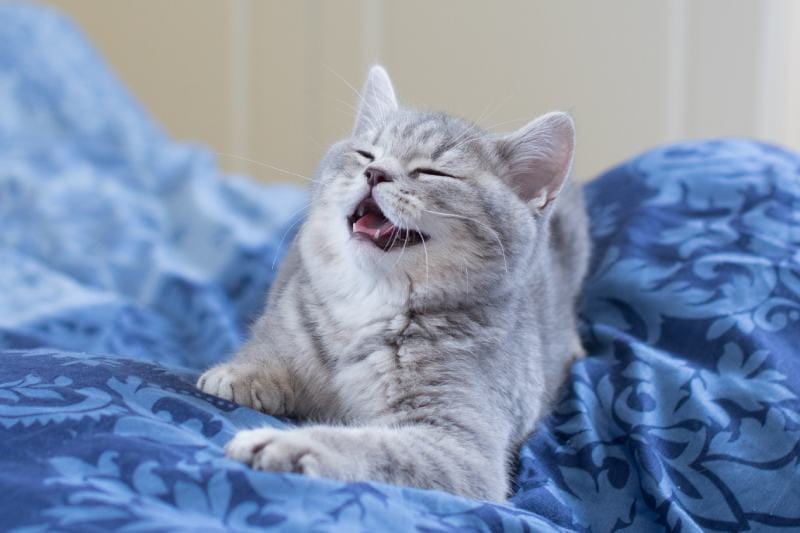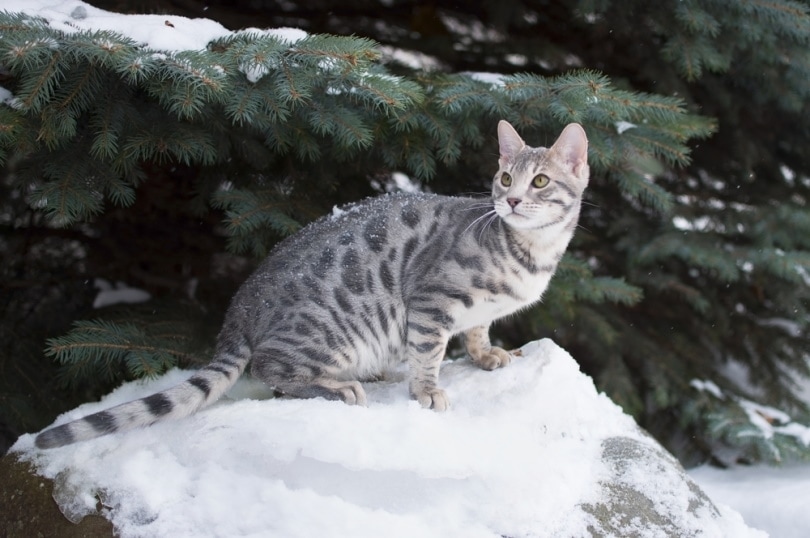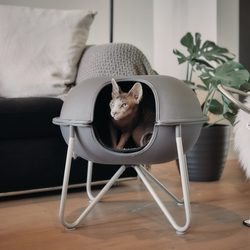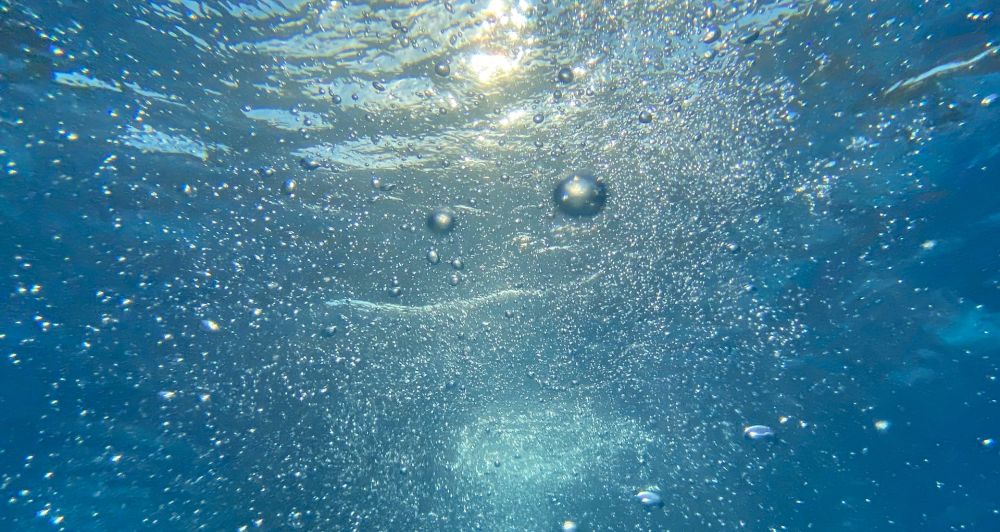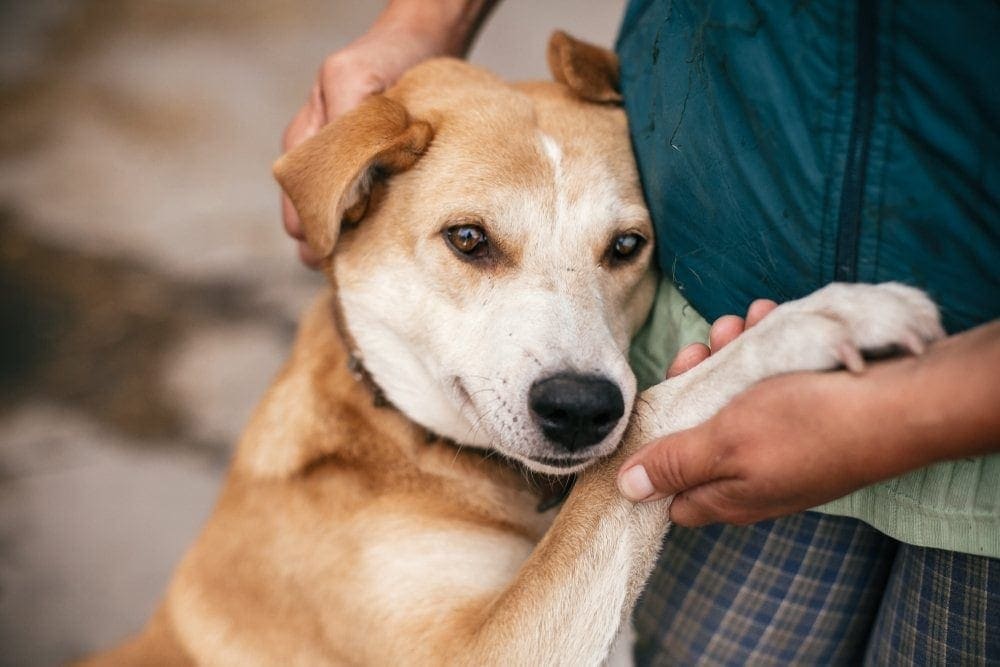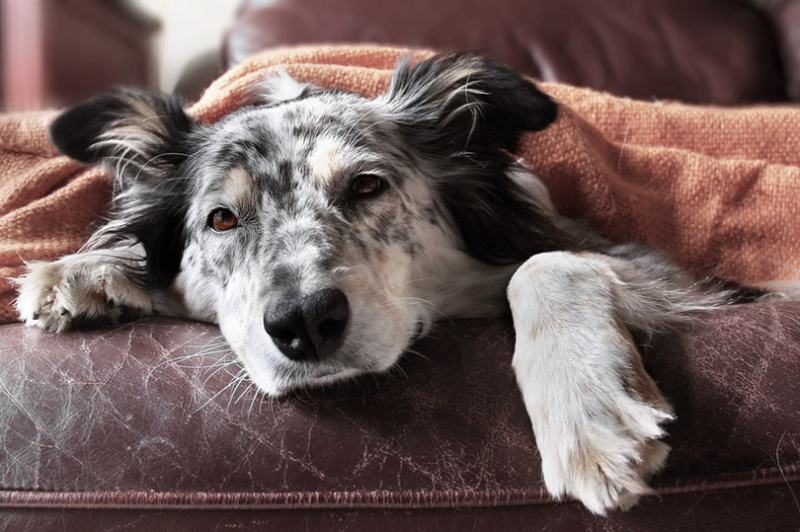25 Famous Cat Paintings: Historic to Modern Masterpieces
Updated on

Click to Skip Ahead
Admiring paintings isn’t everyone’s idea of a good time. But throw a cat in a painting, and suddenly you’ve captured the world’s attention.
Are you interested in knowing which artists adored cats just like you? Today, we’re taking a cultural dive as we talk about 25 famous cat paintings from ancient to modern times.
When we’re done, you’ll have 25 new gift ideas for the cat-loving Pablo Picasso in your life.
Ancient Times to the Medieval Period
1. Tomb of Nebamun

| Artist: | Unknown |
| Date: | 1400–1350 BCE |
| Medium: | Earth pigment on plaster |
The ancient Egyptians didn’t have canvas to paint their pictures. Instead, they painted on walls of tombs, palaces, and slabs of stone. Many cat paintings are dispersed throughout ancient Egypt since cats were worshiped as gods. One painting, in particular, is the hunting scene on the Tomb of Nebamun.
This scene shows Nabamun hunting in the Nile marsh with a cat next to him, catching birds. The cat’s eye gives historians the idea that the cat had a deep religious meaning. The cat may represent the Sun God hunting the enemies of light and order.
2. Grinning Cat
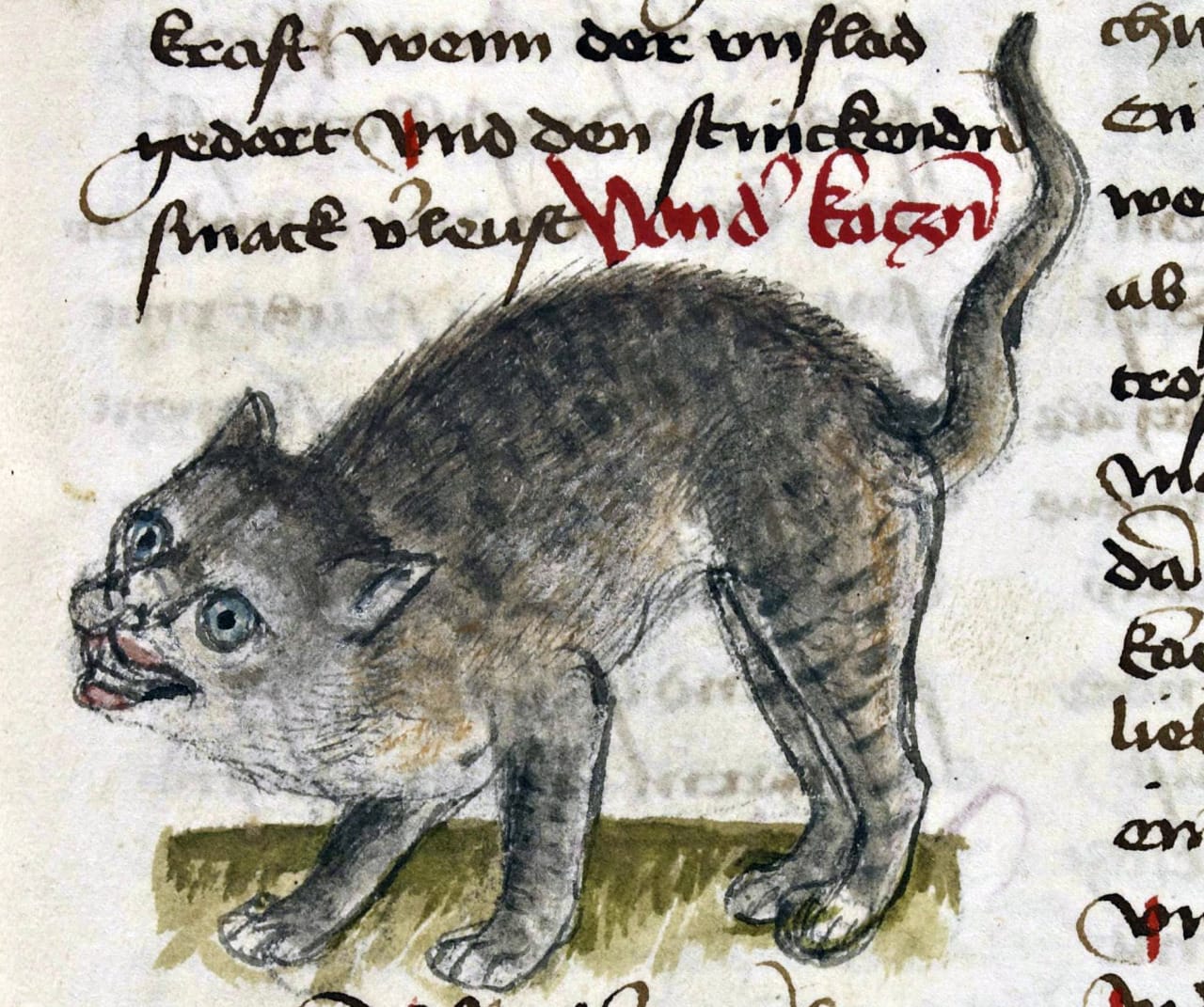
| Artist: | Conrad of Megenberg |
| Date: | 1478 |
| Medium: | Woodcut |
The Grinning Cat in Conrad of Megenberg’s book, Buch der Natur (Book of Nature), is a portrait that people can’t look away from. The cat’s face is a grotesque human face with a disturbing smile instead of the regal cat face we all love. Conrad of Megenberg did this for a reason. In fact, many artists in this time portrayed cats this way. Cats symbolized pagan and Jewish traditions, which were represented in Catholic European paintings as demonic.
If you look at other cat paintings of this time, you’ll know why cats look this way. It wasn’t because the artists couldn’t paint a good cat face. It shows that not all cats were loved by every religion.
Renaissance Period
3. A Barber’s Shop with Monkeys and Cats

| Artist: | Abraham Teniers |
| Date: | 1647 |
| Medium: | Oil on copper |
A Barber’s Shop with Monkeys and Cats, created by Flemish painter Abraham Teniers, realistically depicts monkeys serving cats at a barbershop. Teniers used oil on copper, a popular medium between the 16th and 17th centuries.
The anthropomorphic painting looks almost modern and shows that not all paintings were serious. Usually, we would see humans in place of the animals, but its whimsical display of monkeys running a barbershop is proof that, even then, cats knew their place as masters.
18th Century
4. The Black Cat

| Artist: | Min-Zhen |
| Date: | 1730–1791 |
| Medium: | Ink on paper |
The Black Cat is not dated, so it’s hard to say when this beautiful piece was created. Chinese artist Min Zhen was a seal carver who lived most of his life in Hubei. Most of his work included human figures. Min Zhen was associated with the Eight Eccentrics of Yangzhou, a group of painters known for rejecting the typical rules of painting and opting for individual expression.
Most famous paintings used oil on canvas, but this piece used ink on paper. It features a chubby cat smiling at you—very different from how European pictures displayed cats.
19th Century
5. The Cat’s Lunch

| Artist: | Marguerite Gerard |
| Date: | 1800 |
| Medium: | Oil on canvas |
Marguerite Gerard was one of the leading female artists of her time. Gerard liked to illustrate motherhood and female companionship in her paintings and included a pet dog or cat in many of them. Her brother-in-law, Jean-Honoré Fragonard, was also a painter and had cats in his portraits. He probably influenced her to involve cats in her paintings.
The Cat’s Lunch features a young woman holding out a plate of food and the cat clearly enjoying it while the dog eagerly waits for his bite.
6. Curiosity

| Artist: | Horatio Henry Couldery |
| Date: | 19th century |
| Medium: | Oil on canvas |
Couldery was an English cabinet maker before abandoning the trade to focus on art. He’s well known as an artist who mainly focused on animals, specifically cats. He created portraits that captured realistic expressions of animals in mischievous situations. Admirers of his work are in awe at his ability to paint fur that looks so real you could touch it.
Curiosity is one painting in a series that features cats in various scenarios, overpowered by their usual investigative behavior. This painting is the most popular of the series, featuring three cats inspecting a trapped bird. If the bird escaped, we know what would happen next!
7. Gabrielle Arnault as a Child
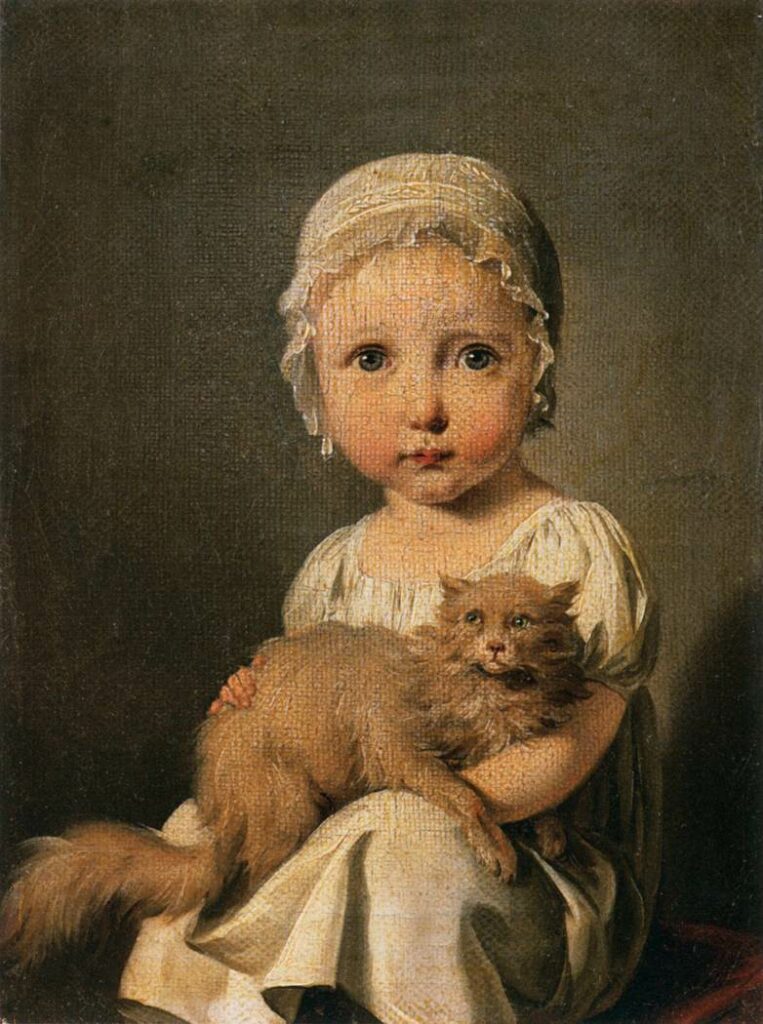
| Artist: | Louis Leopold Boilly |
| Date: | 1815 |
| Medium: | Oil on canvas |
French painter Louis Leopold Boilly rose to fame during the turn of the 19th century for his ability to produce fantastic portraits. At first glance, this painting doesn’t seem like much. It’s a young child holding a cat, and the colors are plain, but the innocence of the kitten and the child is almost tangible. Even the young girl’s eyes seem to draw you in. Ultimately, this painting is about youth.
Of course, as cat lovers, we notice the cat. It’s almost cruel that the cat isn’t looking at us so we can tell it how cute it looks.
8. The Cook and the Cat

| Artist: | Théodule-Augustin Ribot |
| Date: | 1860 |
| Medium: | Oil on canvas |
We all know how sneaky cats can be, and this painting perfectly captures that behavior. Mostly self-taught, Théodule-Augustin Ribot was a French painter and printmaker who practiced painting everyday objects by lamplight. In his later years, he was heavily influenced by Spanish realistic painters and practiced the realism style. It makes sense why a few of his paintings featured kitchen scenes.
This painting depicts a chef preparing his food and his cat at the foot of his stool, reaching out to snatch the fish. You can relate to this portrait if your cat has ever stolen food off your plate or kitchen counters.
9. The Cat At Play

| Artist: | Henriette Ronner-Knip |
| Date: | 1860-1878 |
| Medium: | Oil on canvas |
The Cat At Play shows an adorable black and white kitten pouncing on dominoes. As cat owners, we’re familiar with this stance far too well, and this painting characterizes the playful nature of a kitten just right.
Henriette Ronner-Knip painted animals, forests, and farms using watercolor and oils in her youth. She chose to focus on cats and dogs in the 1850s, but most of her well-known work is from the 1870s. We don’t know the exact date of this painting. It’s believed to date between 1860 and 1878.
10. A White Cat Playing With a String

| Artist: | Hiroshige II |
| Date: | 1863 |
| Medium: | Ink |
If you study Japanese artist Hiroshige II’s work, you’ll see that he followed the style of his artistic mentor. However, this painting is a piece that shows his own style. A White Cat Playing With a String is an ink painting that closely observes a house cat playing with a string, ready to pounce on the next sign of movement.
The portrait is minimal, but the colors are bold and depict an all-too-realistic moment of a cat enjoying the hunt.
11. Girl and Cat

| Artist: | Pierre-Auguste Renoir |
| Date: | 1880 |
| Medium: | Oil on canvas |
Girl and Cat is one of many paintings by French artist Pierre-Auguste featuring cats. He used an impressionist style, using thin yet discernible brush strokes, and captured a perfect moment of cat curiosity. The cat is infatuated with the flowers, and the girl keeps an eye on the cat, so he doesn’t knock over her flowers.
12. Julie Manet With Cat

| Artist: | Pierre-Auguste Renoir |
| Date: | 1887 |
| Medium: | Oil |
Yet another painting by Pierre-Auguste Renoir, Julie Manet With Cat proves the artist’s love for cats. Julie Manet was the child of two friends of Renoir, one of whom was also a painter. His friends commissioned the piece in 1887. Renoir chose a different style other than his usual impressionistic style, which wasn’t well-received by his other friends. The Manet’s, however, loved the portrait of their daughter.
Renoir created at least four drawings to prepare for his work. The final product is a portrait filled with warmth and love.
13. The White Cat

| Artist: | Pierre Bonnard |
| Date: | 1894 |
| Medium: | Oil |
The White Cat can’t help but get a chuckle out of anyone who stares at it. Artist Pierre Bonnard created a humorous photo of a distorted cat arching its back. The style of this painting is heavily inspired by Japanese work with bold, uneven composition. Interestingly, X-rays of this painting revealed that Bonnard made many changes, specifically to adjust the position of the paws and the shape of the body.
Bonnard combined impressionism with modern expressionism. The result? A comical yet intriguing painting of a frazzled cat. You can’t help but love it!
14. Le Chat Noir

| Artist: | Théophile Steinlen |
| Date: | 1896 |
| Medium: | Color lithograph |
In the late 1800s, Le Chat Noir (The Black Cat) was a popular nightclub for new artists and musicians. The owner, Robert Salis, organized a musical tour where the nightclub’s musicians would perform at various locations. Salis asked Théophile Steinlen to create a poster that would attract audience members.
Steinlen was a painter and printmaker at the time, and his career was taking off thanks to Le Chat Noir. Although this isn’t one of his paintings, the poster is one of the most famous cat images.
15. The Bachelor Party

| Artist: | Louis Wain |
| Date: | 1896 |
| Medium: | Oil |
English artist Louis Wain consistently featured cats in his work. His style included cartoonish, colorful cats with large eyes doing things humans would usually do. In this painting, we see a group of bachelors smoking cigars, drinking, and playing cards.
Louis Wain began his career as an art journalist, creating illustrations for newspapers. It didn’t take long for the world to fall in love with his cat creations. Wain’s mental health declined later in life, and in 1924, medical professionals declared him insane. He was transferred to several hospitals for treatment, but he never stopped drawing cats. Cats truly were an inspiration for his work.
20th Century
16. Sara Holding A Cat

| Artist: | Mary Cassatt |
| Date: | 1908 |
| Medium: | Oil |
Sara Holding A Cat is an impressionist painting by Mary Cassatt, a famous female American artist. Cassatt often featured women and children in her paintings, showing life’s more gentle, nurturing side using thick, blunt brush strokes. In this portrait, we see a young child named Sara holding her precious kitty.
Unfortunately, this was one of Cassatt’s last pieces of work. She went completely blind by 1914 and had to give up painting entirely. Thankfully, she gave us cat lovers this artwork that we can all cherish. Does it remind you of your childhood cat?
17. The White Cat

| Artist: | Franz Marc |
| Date: | 1912 |
| Medium: | Oil |
The White Cat is a famous painting by German artist Franz Marc, also known as Tom Cat on a Yellow Pillow. In this painting, we see a sleepy white cat cozied up on a pillow, enjoying an afternoon nap.
Franz Marc is well known for using mysticism to portray animals. Marc applied expressionism, using bold colors to set a mood for innocence, feminine joy, and life. At this time, artists used powerful colors and bold outlines, both of which are represented in this piece and many of his other paintings.
18. The Bridge

| Artist: | Carl Olof Larsson |
| Date: | 1912 |
| Medium: | Watercolor |
Many of the paintings we’ve listed are oil on canvas. However, The Bridge by Swedish painter Carl Olof Larsson is a watercolor painting featuring a young female painter observing a man on a bridge. Her cat sits next to her, equally intrigued. This is one of Larsson’s later works.
Larsson often used muted palettes in his paintings and showcased his family life in his work. He’s best known as a watercolor painter, and his work took him far when reproduction printing used his watercolor paintings to create coloring books.
19. Cat and Her Kittens

| Artist: | Julius Adams II |
| Date: | 1913 |
| Medium: | Oil |
Artists have to find their own voice after years of studying their mentors. Julius Adams II chose cats as his subject for painting. Adams’ style is similar to Henriëtte Ronner-Knip and Louis Eugéne Lambert, other famous artists we’ve mentioned in this list.
We see a young mother cat resting on the ground with her kittens in this painting. You know a cat found a good spot outside when they can lay down and show their belly. The entire scene is serene and loving and encourages you to cuddle your own cat.
20. The Cat

| Artist: | Bart Van Der Leck |
| Date: | 1914 |
| Medium: | Asbestos |
Bart Van Der Leck was a part of De Stijl, a group of artists who leaned toward a geometric art style with strict horizontal and vertical lines. This type of art became known as Neoplasticism, a kind of abstract art that challenged the limits of conventional art.
This painting features a black cat with piercing eyes. Its ears lay flat like the cat is upset with us. Or maybe it doesn’t have traditional cat ears. After reviewing classical Egyptian art in Paris, Van Der Leck chose the colors black, white, red, and orange to showcase more sober colors.
21. Raminou Sitting on a Cloth

| Artist: | Susan Valadon |
| Date: | 1920 |
| Medium: | Oil |
Cats like to find our clean laundry pile, sit on it, or rub their entire body all over the freshly dried laundry. In this painting, Susan Valadon depicts Raminou seated on a cloth. He most likely isn’t supposed to sit on it, but cats don’t care about that, and it’s evident by the smirk on Raminou’s face.
Susan Valadon didn’t always want to be an artist. She started out as a trapeze artist when an accident ended her career at 16 years old. She began posing for artists like Pierre-Auguste Renoir and developed an interest in painting. We’re glad she did because Raminou is a delight to look at.
22. By Day She Made Herself Into A Cat

| Artist: | Arthur Rackham |
| Date: | 1920 |
| Medium: | Ink |
As a child, Arthur Rackham loved drawing so much that he resorted to drawing on his pillow when paper was taken from him. He grew up to become a prolific illustrator, creating pictures for famous books like Peter Pan, Aesop’s Fables, and The Legend of Sleepy Hollow.
Rackham liked to use ink mixed with watercolors to create his paintings. Knowing this, it makes sense why the picture of the cat is so dark.
23. Cat Catching a Bird

| Artist: | Pablo Picasso |
| Date: | 1939 |
| Medium: | Oil |
We often see paintings expressing the curiosity or gentleness of cats. Cat Catching a Bird was painted by one of the most famous painters, Pablo Picasso. This painting is ominous and gives the viewer an unsettled feeling.
In 1939, the world entered World War II, which was a big inspiration for many of Picasso’s paintings at this time. In this painting, we see a cat hunting a bird. The way it’s depicted is surreal and displays aspects of cubism, a style Picasso ushered into the 20th century.
24. The Cat and Two Sparrows

| Artist: | Marc Chagall |
| Date: | 1952 |
| Medium: | Etching |
This work isn’t technically a painting, but it deserves some of the spotlight. Russian-French artist Marc Chagall combined cubism, fauvism, and surrealism to create The Cat and Two Sparrows. It’s an etching stemming from Chagall’s knowledge of other artistic mediums.
This piece is one of a series of etchings commissioned by Ambroise Vollard, a famous art dealer. Here, we see a cat in a dark and messy environment with two sparrows. It’s hard to describe, yet we know what it is. Chagall’s approach to abstract art is truly wonderful.
25. Cat Head

| Artist: | Georg Baselitz |
| Date: | 1966 |
| Medium: | Oil |
German painter Georg Baselitz is known for “upside-down art.” If you ever visit an art gallery featuring his work, the paintings are turned upside down. Baselitz believes that doing so forces people to pay closer attention. He mentioned that the audience always sees something in the painting, regardless of size or what’s on the canvas.
In Cat Head, we have a humanized cat dominating a small dog. The colors are dark, and the setting is militant. If we consider that Germany was post World War II in 1966 by only 20 years, it makes sense why Baselitz created this painting in this way.
Conclusion
The great thing about this list? There are so many more cat paintings out there! It’s one more reason why cats believe they are superior to humans. We can’t stop uplifting them in our art, but that’s okay. Cats have a special place in this world, in our hearts, and on the canvas.
See also:
Featured Image Credit: poverss, Pixabay


